Μεταμορφώνω
Μετασχηματισμός : Αυτό το εργαλείο σάς επιτρέπει να περιστρέψετε, να κλιμακώσετε και να μεταφράσετε το επιλεγμένο επίπεδο. Αρπάζοντας μία από τις λαβές gizmo, μπορείτε να περιοριστείτε σε όποιον άξονα κάνετε κλικ.
– Το Transform gizmo είχε τη δυνατότητα διαχωρισμού (αν χρειάζεται) κλίμακας, περιστροφής και μετάφρασης χρησιμοποιώντας πλήκτρα (QWER) ή droplist.
– Το Gizmos πήρε κάποιο “αόρατο πάχος” για ευκολία λήψης.

Μπορείτε επίσης να μετατρέψετε χειροκίνητα ένα αντικείμενο με ένα gizmo εισάγοντας ακριβείς παραμέτρους. Για αυτό, τοποθετήστε το δείκτη του ποντικιού σε ένα από τα στοιχεία χειριστή. Όταν τονίζει το κίτρινο, το ρυθμιστικό μπορεί να μετακινηθεί με πατημένο το LMB.
Μπορείτε να περιστρέψετε το αντικείμενο σε βήματα 45 μοιρών εάν πατήσετε (κρατήσετε πατημένο) Ctrl και LMB.
Εάν πρέπει να αλλάξετε με ακρίβεια τις παραμέτρους, τοποθετήστε τον δείκτη στο στοιχείο χειριστή, κρατήστε τον με το κλικ LMB και πατήστε το πλήκτρο διαστήματος στο πληκτρολόγιο ενώ κρατάτε πατημένο το LMB. Εισαγάγετε τις παραμέτρους στο παράθυρο που μόλις άνοιξε.
Δείτε επίσης
Μεταμορφώστε τα αντικείμενα του επιπέδου VoxTree ξεχωριστά
Βελτιώσεις εργαλείων μετασχηματισμού
Μεταμορφώστε τις ενημερώσεις Gizmo .
Μπορείτε επίσης να εκτελέσετε μια περιστροφή με βάση την οθόνη χρησιμοποιώντας τον μεγάλο εξωτερικό κύκλο. Οι επιλογές για αυτό το εργαλείο είναι:
- Μετακίνηση μόνο gizmo: Αυτό σας επιτρέπει να κάνετε προσαρμογές αποκλειστικά στο gizmo. Αυτό βοηθά όταν πρέπει να τοποθετήσετε το gizmo σε άλλη τοποθεσία.
- Αφήστε τον περιστρεφόμενο άξονα: Αυτό είναι υπέροχο όταν περιστρέφετε ένα αντικείμενο πολλές φορές, ενώ διατηρείτε τις προηγούμενες περιστροφές του.
- Θέση & Άξονες (1,2 & 3): Αυτές οι παράμετροι σάς επιτρέπουν να πληκτρολογείτε χειροκίνητα τη θέση και τις περιστροφικές συντεταγμένες.
- Κλίμακα (X, Y & Z): Αυτές οι παράμετροι σάς επιτρέπουν το χειροκίνητο κλειδί σε βαθμωτές διαμορφώσεις.
- Επαναφορά άξονα/χώρου: Αυτές οι δύο λειτουργίες σάς επιτρέπουν να επαναφέρετε τον άξονα ή τον τοπικό χώρο ενός αντικειμένου.
– Χρήση κανόνων πλοήγησης για μετασχηματισμό: Πατώντας το πλήκτρο N, μπορείτε να χρησιμοποιήσετε την πλοήγηση με το ποντίκι για να μεταμορφώσετε αντικείμενα.
Ενεργοποιήστε/απενεργοποιήστε το QWER

* Object Gizmo και Gizmo Less Transform : του Anton Tenitsky.
Instancer
Μια μέθοδος εξοικονόμησης μνήμης για τη δημιουργία αντιγράφων των αντικειμένων voxel σας.
Οι περιπτώσεις καταναλώνουν πολύ λιγότερη μνήμη από τις διπλότυπες. Μπορείτε να “Κλωνοποιήσετε” μια παρουσία (μενού δεξί κλικ) και να “Συγχώνετε” νέα αντικείμενα ως στιγμιότυπα. Οι αρνητικοί όγκοι μπορεί επίσης να είναι περιπτώσεις.
Αυτό το εργαλείο θα βοηθήσει στη δημιουργία περιπτώσεων. Τα στιγμιότυπα είναι αναφορές σε υπάρχοντα αντικείμενα, επομένως καταλαμβάνουν σχεδόν μηδενική μνήμη. Εάν έχετε κάποιο στοιχείο που μπορεί να χρησιμοποιηθεί πολλές φορές σε ξεχωριστό τόμο, μπορείτε να το χρησιμοποιήσετε ως παράδειγμα. Για παράδειγμα, μπορεί να είναι τούβλο ή κάποια μηχανική λεπτομέρεια. Μπορείτε να δημιουργήσετε κατοπτρισμένες περιπτώσεις, για παράδειγμα, αριστερό και δεξί βραχίονα.
Κίνηση
Move : Αυτό το εργαλείο είναι ένα από τα πιο ισχυρά και ευέλικτα εργαλεία στο οπλοστάσιο voxel. Όχι μόνο μπορεί να «ρυθμίσει» οποιοδήποτε σχήμα, μεγάλο ή μικρό, αλλά μπορεί επίσης να λειτουργήσει ως εργαλείο «Εξώθησης/Εισβολής».
Σύρετε με το “LMB” για να μετακινήσετε την επιφάνεια εντός της περιοχής του δρομέα σε σχέση με την προβολή οθόνης. Κρατήστε πατημένο το πλήκτρο «Ctrl» για να μετακινήσετε την επιφάνεια κατά μήκος του κανονικού. Το εργαλείο “Μετακίνηση” αλληλεπιδρά επίσης με το Brush Alphas, παρέχοντας διάφορα εφέ.
ThroughAllVolumes (TransPose & Move Tool Changes) : Αυτό το βίντεο καλύπτει τις αλλαγές που έγιναν στα εργαλεία Pose & Move.
– Επιλογή: Προσαρμόστε το Retopo Mesh στο Sculpt
- Conform Retopo Mesh to Sculpt : Αυτό το βίντεο δείχνει μια ενημέρωση της λειτουργίας “Conform Retopo Mesh” στον χώρο εργασίας Sculpt του 3DCoat, η οποία επιτρέπει στον χρήστη να δει το Retopo Mesh (στον χώρο εργασίας Sculpt) ενώ κάνει επεξεργασίες μεγάλης κλίμακας με το Pose, Move , ή εργαλείο μετασχηματισμού.
Καλύπτει επίσης ορισμένες πρόσθετες συμβουλές για να κάνετε το πλέγμα Retopo να συμμορφώνεται μετά την επεξεργασία με τα πινέλα Sculpting.
Voxelize αμέσως : Μόλις ολοκληρωθεί η κίνηση, η επιφάνεια θα γίνει αμέσως voxelized. Απενεργοποιήστε αυτό το πλαίσιο ελέγχου εάν θέλετε να κάνετε πολλές κινήσεις και να κάνετε voxelize αμέσως μόλις μεταβείτε σε οποιοδήποτε εργαλείο voxel.
Τοπολογική κίνηση: Μετακίνηση μόνο συνδεδεμένη με τα κεντρικά μέρη. Χρησιμοποιήστε το για να κλείσετε τρύπες και να μετακινήσετε αυτό που θέλετε να μετακινήσετε και όχι τα πάντα κάτω από τη βούρτσα. Είναι ένα πολύ χρήσιμο πινέλο για τη γλυπτική στενών λεπτομερειών, όπως τα χείλη, τα μάτια και τα δάχτυλα.
Στάση
Το 3DC 2023 πρόσθεσε τη δυνατότητα Soft Selection για το εργαλείο Pose στον χώρο εργασίας Sculpt.
Pose : Αυτό το εργαλείο είναι ιδανικό για γρήγορη αλλαγή της περιστροφής, της κλίμακας και της μετάφρασης μιας επιλογής. Μπορείτε να καθορίσετε την επιλογή με διάφορους τρόπους. Μπορείτε να χρησιμοποιήσετε μια γραμμή, ένα δαχτυλίδι ή μια σφαίρα και μπορείτε ακόμη και να ζωγραφίσετε πάνω του με ένα Brush ή ένα αντικείμενο. Ελέγξτε τη λειτουργία Airbrush όταν χρησιμοποιείτε το “Select with a pen” για να αυξήσετε ομαλά την περιοχή επιλογής.
Αφού γίνει μια επιλογή, θα εμφανιστεί ένα ειδικό gizmo πόζας.
Απενεργοποιώντας το Regular Gizmo, το εργαλείο έχει τρεις καταστάσεις: Περιστροφή, Κλίμακα και Μετάφραση.
Μπορείτε να αλλάξετε λειτουργίες κάνοντας κλικ στη μακριά κόκκινη ορθογώνια γραμμή στη βάση του gizmo. Σε κάθε κατάσταση, το gizmo έχει ένα σύνολο παραμέτρων στον πίνακα επιλογών του εργαλείου.
Τέλος, όπως με όλα τα εργαλεία στο 3DCoat, το εργαλείο πόζας σέβεται τη συμμετρία, καθώς και όλες τις λειτουργίες επιλογής, όπως ορθογώνιο μεταφοράς, λάσο κ.λπ. Τώρα, το εργαλείο Pose λειτουργεί σε όλα τα ορατά αντικείμενα (μέσω όλων των τόμων).
Ας ρίξουμε τώρα μια ματιά σε μερικές από τις παραμέτρους Transpose Mode:
- Ορατότητα παγώματος/πόσης: Η αδιαφάνεια της επιλογής πόζας ή παγώματος.
- Ενέργεια πόζας:
- Μετακίνηση από Gizmo.
- Κανονική εξώθηση.
- Γραμμή: Αυτή η λειτουργία σάς επιτρέπει να σχεδιάσετε μια κλίση με βάση τη γραμμή για χρήση με το εργαλείο πόζας gizmo. Ξεκινά με το αρχικό σας κλικ LMB και τελειώνει με την απελευθέρωση του LMB.
- Δακτύλιος: Επιλέγει μια κλίση που βασίζεται σε δακτύλιο. Ξεκινά με το αρχικό σας κλικ LMB και τελειώνει με την απελευθέρωση του LMB.
- Sphere: Επιλέγει μια σφαιρική κλίση. Ξεκινά με το αρχικό σας κλικ LMB και τελειώνει με την απελευθέρωση του LMB.
– Snap to Angle: Ενεργοποιήστε εάν χρειάζεστε μια επιλογή Snap to Angle.
- Επιλογή ζωγραφικής: Η επιλογή με τη λειτουργία στυλό σάς επιτρέπει να βουρτσίζετε απευθείας την επιλογή σας. Το μέγεθος του στυλό επηρεάζει άμεσα την περιοχή επιλογής. Επιπλέον, μπορείτε επίσης να εξομαλύνετε την επιλεγμένη περιοχή κρατώντας πατημένο το “Shift + LMB”. Αυτός είναι ένας πολύ καλός τρόπος για να επιλέγετε πράγματα γρήγορα εάν χρειάζεστε μόνο μικρές μικρές λεπτομέρειες.
Σημείωση: Η λειτουργία “Επιλογή ζωγραφικής” είναι πολύ χρήσιμη. Με το εργαλείο Pose, μπορείτε να χρησιμοποιήσετε σχεδόν οποιαδήποτε μέθοδο επιλογής στον πίνακα “E”, όπως σύρετε ορθογώνιο, λάσο κ.λπ. Μπορείτε επίσης να αφαιρέσετε την επιλογή σας χρησιμοποιώντας το κανονικό εργαλείο κρατώντας πατημένο το πλήκτρο CTRL.
- Λειτουργία Airbrush: Ενεργοποιήστε τη λειτουργία airbrush. Μπορείτε επίσης να επιλέξετε ομαλά περιοχές αντί να έχετε μια επιλογή με σκληρό άκρο. Κάνει τακτοποιημένες παραμορφώσεις γύρω από τις άκρες της επιλογής σας.
- Επιλογή αντικειμένου: Αυτή η λειτουργία μπορεί να είναι χρήσιμη εάν έχετε πολλά αντικείμενα στο Sculpt Tree. Απλώς κάντε κλικ στο αντικείμενο που θέλετε να παραμορφώσετε χρησιμοποιώντας το εργαλείο Pose, το οποίο θα τοποθετήσει ολόκληρο τον τόμο ως επιλογή σας.
- Καθαρή επιλογή:
- Invert Selection: Αντίστροφη επιλογή πόζας.
- Αποθήκευση επιλογής: Αποθήκευση επιλογής πόζας στο αρχείο. Συνιστάται να το χρησιμοποιείτε σε λειτουργία επιφάνειας. Εάν η δομή του πλέγματος αλλάξει λόγω voxelization, δεν θα μπορείτε να εφαρμόσετε την προηγούμενη επιλογή αποθήκευσης.
- Φόρτωση επιλογής: Φόρτωση επιλογής πόζες από το αρχείο. Εάν αλλάξει η δομή του πλέγματος, δεν μπορείτε να επαναφέρετε την επιλογή, επομένως χρησιμοποιήστε την σε λειτουργία επιφάνειας όποτε είναι δυνατόν.
- Smooth Selection: Smooth Pose Selection.
- Αποθήκευση επιλογής στο επίπεδο: Αποθήκευση επιλογής θέσης ως στρώμα.
- Επιλέξτε επιλογή από το Επίπεδο: Ανάκληση επιλογής με κλικ.
– Χρήση ελεύθερης φόρμας: Αυτή η δυνατότητα επιτρέπει σε ένα πλέγμα να παραμορφώσει την επιλεγμένη περιοχή πόζας. Επιλέξτε από πολλά σχήματα πλέγματος για να μετατρέψετε την επιλογή Pose.
– Εφαρμόστε το Transform στο Gizmo.
- Κανονικό Gizmo: Χρησιμοποιήστε ένα κανονικό gizmo αντί για ένα που βασίζεται σε γραμμή.
- Απόκρυψη Gizmo:
- Προσαρμογή περιοχής μετάβασης: Προσαρμόστε την περιοχή που ενώνει μη επιλεγμένες και πλήρως επιλεγμένες περιοχές. Επιτρέπει την κάμψη πιο ακριβή και φυσική.
- Move Only Gizmo: Μετακινήστε το gizmo αλλά μην μεταμορφώσετε το αντικείμενο.
- Αφήστε τους περιστρεφόμενους άξονες: Μετά την περιστροφή, οι άξονες θα παραμείνουν στην τελική κατάσταση. Διαφορετικά, θα επιστρέψουν στον προσανατολισμό X, Y και Z.
- Pick Pivot: Κάντε κλικ για να επιλέξετε το σημείο περιστροφής από την επιφάνεια.
- Μόνο επιλογή θέσης: Επιλέξτε τη θέση και τον άξονα Υ από το κανονικό της στυλό και τη θέση των αξόνων Χ και Ζ από τον προσανατολισμό της πένας.
- Επιλογή Κανονικής & Θέσης: Επιλέξτε τη θέση και τον άξονα Υ από την κανονική και τη θέση της πένας, τους άξονες Χ και Ζ από τον προσανατολισμό της πένας.
- Pick View Direction & Position: Επιλέξτε θέση gizmo από το σημείο επιλογής, άξονα Y από την κατεύθυνση προς τα εμπρός, X – δεξιά, Z – επάνω.
- Επαναφορά άξονα.
- Επαναφορά χώρου: Επαναφέρετε τον τοπικό χώρο του αντικειμένου, ώστε να κλιμακώνεται ομοιόμορφα κατά μήκος όλων των αξόνων και οι κατευθύνσεις των τοπικών αξόνων θα προσανατολίζονται σε καθολικά X, Y και Z.
- Κέντρο στον τοπικό χώρο: Επικεντρώστε το gizmo στον τοπικό χώρο. Ο άξονας θα προσανατολιστεί κατά μήκος του τοπικού άξονα, εάν επιλέξετε “Αποχώρηση από το περιστρεφόμενο gizmo”.
- Προς τον κύριο άξονα: Κατευθύνετε τον άξονα gizmo κατά μήκος του κύριου γεωμετρικού άξονα του αντικειμένου.
- To Center Mass: Μετακινήστε το gizmo στο κέντρο μάζας.
- To Bound Center: Μετακινήστε το gizmo στο κέντρο του δεσμευμένου πλαισίου.
- Στοίχιση για προβολή:
- Εφαρμογή στο Transform to Gizmo: Εφαρμογή για μετατροπή σε ολόκληρο το gizmo.
TransPose Tool Poly Groups : Αυτό το βίντεο δείχνει μερικές νέες προσθήκες λειτουργιών στο Pose Tool στο 3DCoat 4.9. Το ένα είναι το κούμπωμα γωνίας για ακριβείς γραμμικές επιλογές. Η άλλη είναι η λειτουργία Poly Group που είναι ενσωματωμένη στο εργαλείο Pose.
Πώς να κάνετε τέτοιου είδους ανατροπές

Philnolan3d: Θα μπορούσατε να παίξετε με το εργαλείο Pose για να αποκτήσετε διαφορετικά σχέδια. Αυτό το έκανα γρήγορα με τη λειτουργία επιλογής Ring. Απλώς σύροντας την επιλογή μου κατά μήκος κοντά στη μέση, και μετά κοιτάζοντας προς τα κάτω το μήκος, γύρισα το gizmo.
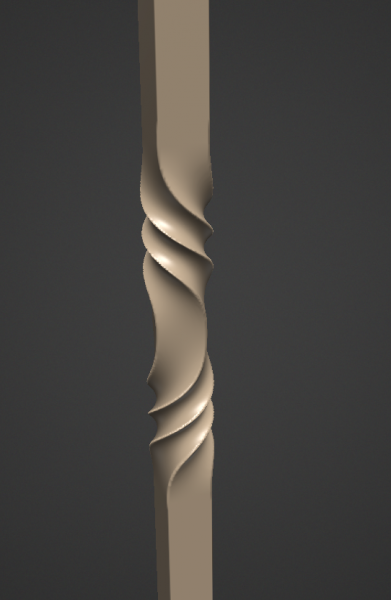
Στροφή
Λυγίστε το αντικείμενο γύρω από τον άξονα, ο οποίος θα λυγίσει ή θα τυλίξει το τρέχον στρώμα γύρω από τη βάση του gizmo.
Το Sculpt room προστέθηκε ένα νέο εργαλείο Bend .
Επιλογές εργαλείου:
- Προεπισκόπηση των περιστρεφόμενων αξόνων: Είναι σημαντικό γιατί, χωρίς αυτόν τον άξονα, τίποτα δεν κατανοούσε τι συμβαίνει εκεί.
- Προεπισκόπηση Αμέσως: Προεπισκόπηση της ενέργειας στρέβλωσης αμέσως.
- Ακτίνα κάμψης:
- Το Gizmo είναι το κέντρο παραμόρφωσης: Ο άξονας gizmo είναι ο κεντρικός άξονας της παραμόρφωσης.
- Μέγιστη γωνία κάμψης: Η μέγιστη γωνία κάμψης του αντικειμένου.
- Μέθοδος κάμψης: Λυγίστε και τα δύο άκρα, Λυγίστε τη μία πλευρά και Λυγίστε την άλλη πλευρά.
- Θέση: Μετάφραση στον άξονα XYZ. Πατήστε X για επανεκκίνηση της θέσης στο Global Space 0,0,0.
- Περιστροφή: Μπορείτε να περιστρέψετε Περισσότερα στο Διάστημα οθόνης ή να περιστρέψετε επιλεκτικά στον άξονα XYZ.
- Επαναφορά άξονα: Επανεκκινήστε την περιστροφή gizmo στο Local Place.
- Στοίχιση για προβολή: Ευθυγράμμιση με την τρέχουσα προβολή χώρου προβολής.
- Εφαρμογή: εφαρμόστε όλους τους μετασχηματισμούς.
Συστροφή
Σε μια συστροφή ή γραμμική διάταξη, το αντικείμενο θα περιστρέψει το τρέχον Επίπεδο γύρω από τον πόλο του.
Επιλογές εργαλείου:
- Αριθμός τμημάτων: Τμήματα που θα τοποθετηθούν κατά μήκος ενός κύκλου ή τμήματος. Αυξάνεται/Μειώνεται.
- Γωνία περιστροφής: Περιστρέφει το τρέχον αντικείμενο γύρω από το gizmo.
- Κλίμακα βημάτων: Η απόσταση μεταξύ των βημάτων.
- Επικάλυψη: Μειώνει κάθε τμήμα όπου συναντώνται, αυξάνοντας/μειώνοντας ταυτόχρονα το διάστημα μεταξύ κάθε σπείρας.
- Θέση: Μετάφραση στον άξονα XYZ. Πατήστε X για επανεκκίνηση της θέσης στο Global Space 0,0,0.
- Περιστροφή: Μπορείτε να περιστρέψετε Περισσότερα στο Διάστημα οθόνης ή να περιστρέψετε επιλεκτικά στον άξονα XYZ.
- Επαναφορά άξονα: Επανεκκινήστε την περιστροφή gizmo στο Local Place.
- Στοίχιση για προβολή: Ευθυγράμμιση με την τρέχουσα προβολή χώρου προβολής.
- Εφαρμογή: εφαρμόστε όλους τους μετασχηματισμούς.
Στημόνι
Warp : Σας επιτρέπει να περιστρέψετε και να λυγίσετε το τρέχον επιλεγμένο επίπεδο αντικειμένου στο Voxtree.
Επιλογές εργαλείου:
- Αριθμός τμημάτων: Τμήματα που θα τοποθετηθούν κατά μήκος ενός κύκλου ή τμήματος. Αυξάνει/Μειώνει τον αριθμό των τμημάτων.
- Έναρξη/Τελική Γωνία: Γωνία έναρξης του τμήματος.
- Βήμα προς τα εμπρός: Δημιουργήστε μια εμφάνιση “σπιράλ σκάλας”: θα φέρει το αντικείμενο προς τα πάνω.
- Κλίμακα βημάτων: Η απόσταση μεταξύ των βημάτων.
- Επικάλυψη: Πρόσθετη επικάλυψη μεταξύ τμημάτων. Αυτό μειώνει κάθε τμήμα όπου συναντώνται. Το εφέ θα ποικίλλει ανάλογα με το αντικείμενο.
- Θέση: Μετάφραση στον άξονα XYZ. Πατήστε X για επανεκκίνηση της θέσης στο Global Space 0,0,0.
- Περιστροφή: Μπορείτε να περιστρέψετε Περισσότερα στο Διάστημα οθόνης ή να περιστρέψετε επιλεκτικά στον άξονα XYZ.
- Επαναφορά άξονα: Επανεκκινήστε την περιστροφή gizmo στο Local Place.
- Στοίχιση για προβολή: Ευθυγράμμιση με την τρέχουσα προβολή χώρου προβολής.
- Εφαρμογή: εφαρμόστε όλους τους μετασχηματισμούς.
Αξονικός
Αξονική : Ορισμένες εφαρμογές το ονομάζουν “Radial Symmetry”. Οποιοδήποτε στρώμα Voxel μπορεί να αντιγραφεί και να περιστραφεί σε αριθμό και γωνία από έναν κεντρικό άξονα. Χρησιμοποιήστε το “Axial count” για να προσδιορίσετε τον συνολικό αριθμό αντιγράφων. Μπορείτε να συγχωνεύσετε αυτά τα αντίγραφα ως ξεχωριστές παρουσίες εάν το επιθυμείτε. Το αξονικό εργαλείο σάς επιτρέπει να κλωνοποιήσετε το ενεργό στρώμα από το δέντρο Sculpt με αξονική συμμετρία.
Μπορείτε να ορίσετε τον αριθμό των αντιγράφων στην καρτέλα Array Count. Το gizmo λειτουργεί ακριβώς όπως όλα τα άλλα gizmo, επομένως δεν πρέπει να είστε ξένοι σε αυτό. Μετακινήστε το πρόγραμμα χειρισμού μετάφρασης για να πάρετε μια ιδέα για παρόμοια πράγματα που μπορείτε να κάνετε με αυτό.
Πώς να κάνετε τέτοιου είδους ανατροπές;
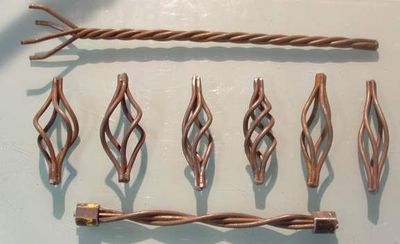
Αξονικό εργαλείο
Αφράτα: Για στριμμένα αντικείμενα που αποτελούνται από πολλά μέρη όπως αυτά στην παραπάνω εικόνα, μπορείτε να δοκιμάσετε χρησιμοποιώντας την παρακάτω μέθοδο…
Πρώτα, δημιουργήστε ένα κομμάτι του αντικειμένου και μετατοπίστε το από το κέντρο της σκηνής, μετά μεταβείτε στο εργαλείο Αξονικό (στην ενότητα Μετασχηματισμός του πίνακα εργαλείων) και ορίστε τον αριθμό των πρόσθετων εξαρτημάτων που θέλετε και τη θέση και τον προσανατολισμό του τον άξονα κατά μήκος του οποίου θα δημιουργηθούν τα αντίγραφα, θυμηθείτε να ενεργοποιήσετε την επιλογή Instance…
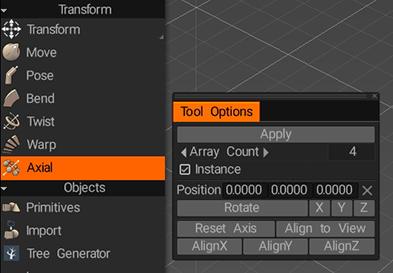
Αφού εφαρμόσετε το εργαλείο Axial, μπορεί να σας φανεί χρήσιμο να εμφανίσετε τα επίπεδα που δημιουργήθηκαν πρόσφατα για να διευκολύνετε την εργασία στο αρχικό αντικείμενο. Μπορείτε να το κάνετε αυτό κάνοντας ALT+κάνοντας αριστερό κλικ στο εικονίδιο φάντασμα στο επίπεδο γονικού αντικειμένου.
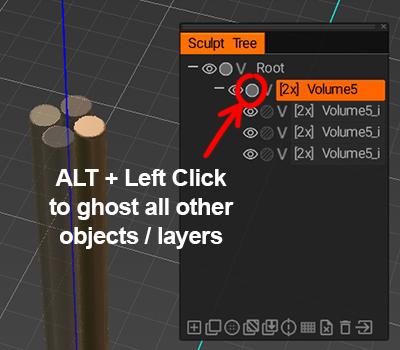
Αφού το κάνετε αυτό, μπορείτε να χρησιμοποιήσετε το εργαλείο Μετακίνηση (που βρίσκεται επίσης στην ενότητα Μετασχηματισμός του πίνακα εργαλείων) για να προσθέσετε το απαιτούμενο κενό μεταξύ των αντικειμένων. Δεδομένου ότι όλα τα άλλα αντικείμενα είναι παρουσίες του αντικειμένου στο οποίο εργάζεστε, τυχόν αλλαγές που κάνετε θα επηρεάσουν όλα τα αντίγραφα του αντικειμένου.
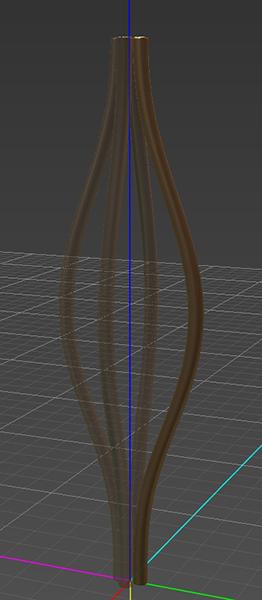
Τέλος, χρησιμοποιήστε το εργαλείο Twist (που βρίσκεται πάλι στην ενότητα Μετασχηματισμός του πίνακα εργαλείων) για να προσθέσετε την επιθυμητή ποσότητα περιστροφής στα αντικείμενα…
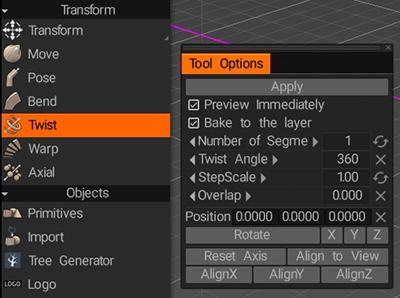
Σε αυτό το σημείο, θα πρέπει να καταλήξετε σε ένα αποτέλεσμα παρόμοιο με αυτό…
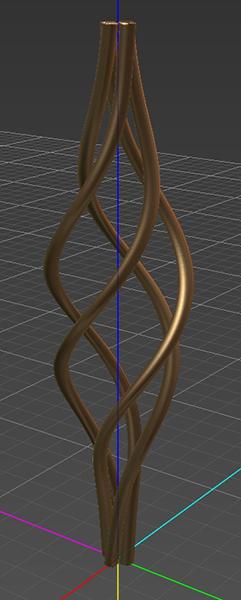
 Ελληνικά
Ελληνικά  English
English Українська
Українська Español
Español Deutsch
Deutsch Français
Français 日本語
日本語 Русский
Русский 한국어
한국어 Polski
Polski 中文 (中国)
中文 (中国) Português
Português Italiano
Italiano Suomi
Suomi Svenska
Svenska 中文 (台灣)
中文 (台灣) Dansk
Dansk Slovenčina
Slovenčina Türkçe
Türkçe Nederlands
Nederlands Magyar
Magyar ไทย
ไทย हिन्दी
हिन्दी Tiếng Việt
Tiếng Việt Lietuviškai
Lietuviškai Latviešu valoda
Latviešu valoda Eesti
Eesti Čeština
Čeština Română
Română Norsk Bokmål
Norsk Bokmål